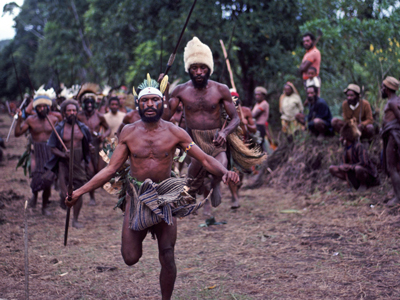43. The rescuing card |
Sven speaks: I have previously told you about Kundi Pok being in Sweden when his son was killed in a car accident and how he refused to accept compensation or any blood revenge because of his son’s death. This decision was widely reported and known of in the Highlands. As far as I can remember, his tribe was never involved in any wars from then on. There were also other villages that were changed in this way. To refuse the vengeance of blood revenge was of great significance for the societies. 
But there were obviously tribes in which we had planted churches that were still involved in tribal fights for different reasons. The authorities used to manage the tribal wars by letting the tribes fight for a while, but when the fighting lasted for a longer period of time, they sent the riot police to the villages. The riot police burned down the houses, destroyed their gardens and killed their pigs in an attempt to end the fighting. The idea was that the villagers would have to deal with the reconstruction of their village and thus stop fighting each other. Usually, these measures lead to the situation eventually becoming peaceful and compensation being paid to the tribe that had lost the most people. The tribe that won had to pay the losers in order to stop further fighting.
Peace settlement. Money, to be paid to the losing tribe, is pinned on the round piece of cardboard. In spite of the fact that our churches, members and pastors, were not involved in the hostilities, and disagreed with the behavior of their tribe, and rather tried to stop the fighting, the riot police destroyed their houses and gardens as well. In late 1984 or possibly early 1985, Kundi and I thought about how we could help our members to avoid having their property destroyed. To discuss the issue further, we made an appointment to see the western highland police commander. We pointed out that none of our pastors or members participated in the tribal fighting but they tried to stop their people from fighting one another. "We think that it's unfair that our church members’ properties are burned down by the riot police." we said to the police commander. He understood the problem and asked if we had thought of a solution to this problem. "We want to make an ID card for our pastors to carry, that contains information about the pastor and also instructions to the riot police, saying that they cannot burn down either the pastor's or his church members' houses and gardens." "Sounds good to me." he replied. "Make a sample design and come back to see me again." |
We made an ID card with the name and photo of the pastor with our church seal covering part of the photo. There was also information of the name of the church, the pastor was looking after including the name of the village it was located in, together with the pastor's signature. On the inside of the folded card it was written, "This card is to advise that the holder, whose name and signature appears on the front, and whose photo with our seal appears in the right hand corner, is a pastor of the local church, named on the front of this card. The members of this church will not be participating in any tribal fight, but will work with the police to stop such fighting. Neither will they be involving themselves in receiving or giving compensation payments for people killed." This part was signed by Kundi Pok and myself originally, but later by the regional superintendent and regional secretary. The card was issued for 12 months validity and renewed every year. On the back of the card was written: Police Officers, when there is a fight in this village, please respect this card. Do not put this man or any of his church members in jail. This section was signed by the Western Highlands police commander and sealed with his official seal.
The front and the back of the ID card. When we showed the proposed ID to the Western Highlands police commander he thought that they were very good. At this time, there were churches in about 60 villages involved in all of this. We made ID cards for the pastors of each church. Kundi and I signed on the inside of the folded card, as the ones who had identified the person. The Western Highlands Police Commander signed and sealed the instructions to the Police Officers with the Police official seal on the back of the card as a confirmation that this was an official order from the Western Highlands police commander.
Centre pages of the ID card. This particular card is not signed by Sven. It was issued when Sven was in Australia. These cards proved to work very well. When the riot police came out to the villages, the pastor showed his ID card and pointed out his own and his members' houses and gardens. The riot police cooperated and respected what the pastor said. There were many churches, houses and gardens that thus escaped being burnt down. Although there were many different churches and missions in Papua New Guinea which had ID cards, ours were the only ones that the riot police respected. This created quite a stir in the villages and people in general showed a lot of respect for our work. The reason behind the police's confidence in our work was thanks to Kundi Pok and Sylvester Timbi refusing to involve themselves in any blood revenge when their children were killed in traffic accidents. |